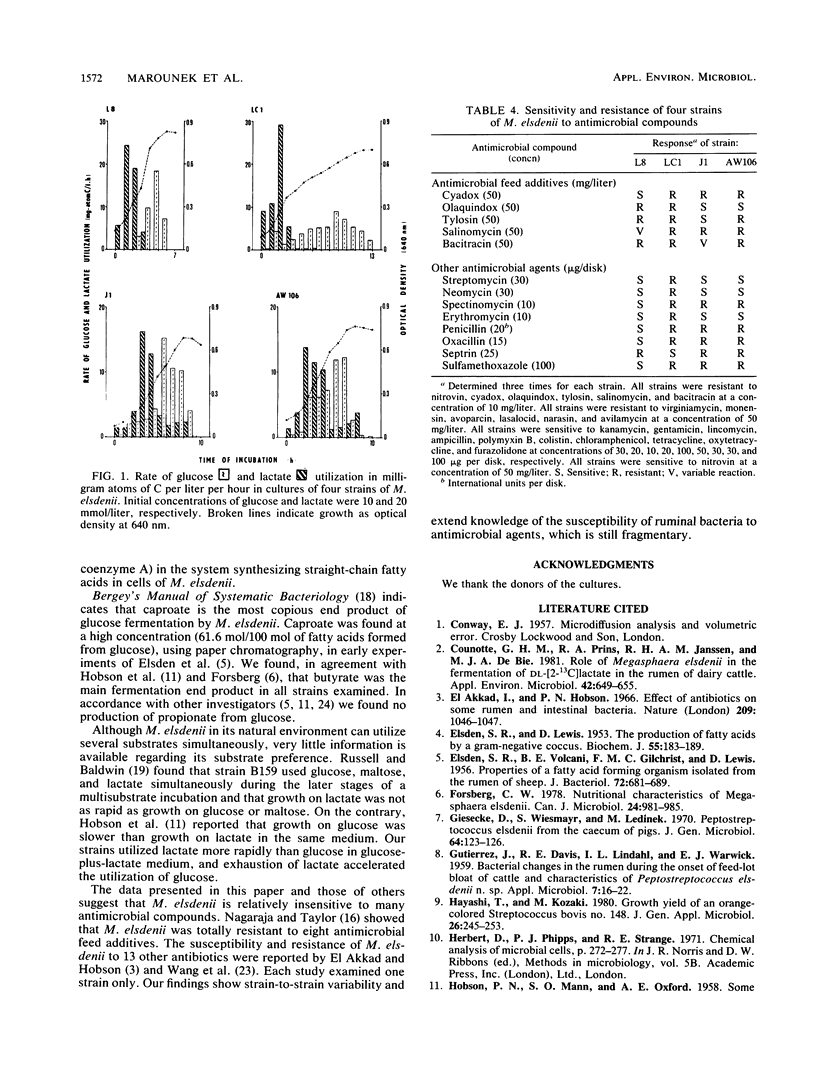Abstract
Megasphaera elsdenii belongs to the group comprising the ruminal and intestinal lactate- and sugar-fermenting species. In the present study the fermentation characteristics, metabolism of glucose and lactate, and susceptibility to antimicrobial agents of four ruminal strains were investigated. Particular attention was given to the mixed-substrate fermentation pattern and resultant fermentation acid profile. Lactate was utilized more rapidly than glucose in media with both carbon sources. Interaction of the two substrates changed the composition of fermentation end products toward more valerate and less propionate in cultures with glucose and lactate. Contrary to the indications in Bergey's Manual of Systematic Bacteriology, butyrate, not caproate, was the main end product of glucose metabolism. The strains examined were rather insensitive to many antimicrobial compounds, especially to ionophores and other antimicrobial feed additives.
Full text
PDF



Selected References
These references are in PubMed. This may not be the complete list of references from this article.
- Counotte G. H., Prins R. A., Janssen R. H., Debie M. J. Role of Megasphaera elsdenii in the Fermentation of dl-[2-C]lactate in the Rumen of Dairy Cattle. Appl Environ Microbiol. 1981 Oct;42(4):649–655. doi: 10.1128/aem.42.4.649-655.1981. [DOI] [PMC free article] [PubMed] [Google Scholar]
- ELSDEN S. R., GILCHRIST F. M., LEWIS D., VOLCANI B. E. Properties of a fatty acid forming organism isolated from the rumen of sheep. J Bacteriol. 1956 Nov;72(5):681–689. doi: 10.1128/jb.72.5.681-689.1956. [DOI] [PMC free article] [PubMed] [Google Scholar]
- ELSDEN S. R., LEWIS D. The production of fatty acids by a gram-negative coccus. Biochem J. 1953 Aug;55(1):183–189. doi: 10.1042/bj0550183. [DOI] [PMC free article] [PubMed] [Google Scholar]
- Forsberg C. W. Nutritional characteristics of Megasphaera elsdenii. Can J Microbiol. 1978 Aug;24(8):981–985. doi: 10.1139/m78-161. [DOI] [PubMed] [Google Scholar]
- GUTIERREZ J., DAVIS R. E., LINDAHL I. L., WARWICK E. J. Bacterial changes in the rumen during the onset of feed-lot bloat of cattle and characteristics of Peptostreptococcus elsdenii n. sp. Appl Microbiol. 1959 Jan;7(1):16–22. doi: 10.1128/am.7.1.16-22.1959. [DOI] [PMC free article] [PubMed] [Google Scholar]
- Giesecke D., Wiesmayr S., Ledinek M. Peptostreptococcus elsdenii from the caecum of pigs. J Gen Microbiol. 1970 Nov;64(1):123–126. doi: 10.1099/00221287-64-1-123. [DOI] [PubMed] [Google Scholar]
- HOBSON P. N., MANN S. O., OXFORD A. E. Some studies on the occurrence and properties of a large gram-negative coccus from the rumen. J Gen Microbiol. 1958 Dec;19(3):462–472. doi: 10.1099/00221287-19-3-462. [DOI] [PubMed] [Google Scholar]
- LADD J. N. The fermentation of lactic acid by a gram-negative coccus. Biochem J. 1959 Jan;71(1):16–22. doi: 10.1042/bj0710016. [DOI] [PMC free article] [PubMed] [Google Scholar]
- LADD J. N., WALKER D. J. The fermentation of lactate and acrylate by the rumen micro-organism LC. Biochem J. 1959 Feb;71(2):364–373. doi: 10.1042/bj0710364. [DOI] [PMC free article] [PubMed] [Google Scholar]
- Marounek M., Bartos S. Interactions between rumen amylolytic and lactate-utilizing bacteria in growth on starch. J Appl Bacteriol. 1987 Sep;63(3):233–238. doi: 10.1111/j.1365-2672.1987.tb04941.x. [DOI] [PubMed] [Google Scholar]
- Nagaraja T. G., Taylor M. B. Susceptibility and resistance of ruminal bacteria to antimicrobial feed additives. Appl Environ Microbiol. 1987 Jul;53(7):1620–1625. doi: 10.1128/aem.53.7.1620-1625.1987. [DOI] [PMC free article] [PubMed] [Google Scholar]
- Russell J. B., Baldwin R. L. Substrate preferences in rumen bacteria: evidence of catabolite regulatory mechanisms. Appl Environ Microbiol. 1978 Aug;36(2):319–329. doi: 10.1128/aem.36.2.319-329.1978. [DOI] [PMC free article] [PubMed] [Google Scholar]
- Sleat R., Mah R. A. Quantitative method for colorimetric determination of formate in fermentation media. Appl Environ Microbiol. 1984 Apr;47(4):884–885. doi: 10.1128/aem.47.4.884-885.1984. [DOI] [PMC free article] [PubMed] [Google Scholar]
- Vervaeke I. J., Van Assche P. F. Occurrence of megasphaera elsdenii in faecal samples of young pigs. Zentralbl Bakteriol Orig A. 1975;231(1-3):145–152. [PubMed] [Google Scholar]
- Wallace R. J. Catabolism of Amino Acids by Megasphaera elsdenii LC1. Appl Environ Microbiol. 1986 May;51(5):1141–1143. doi: 10.1128/aem.51.5.1141-1143.1986. [DOI] [PMC free article] [PubMed] [Google Scholar]
- Wang C. L., Baldwin B. B., Fulghum R. S., Williams P. P. Quantitative antibiotic sensitivities of ruminal bacteria. Appl Microbiol. 1969 Oct;18(4):677–679. doi: 10.1128/am.18.4.677-679.1969. [DOI] [PMC free article] [PubMed] [Google Scholar]
- Werner H. Mesasphaera elsdenii--ein normaler Bewohner des menschlichen Dickdarms. Zentralbl Bakteriol Orig A. 1973 Mar;223(2):343–347. [PubMed] [Google Scholar]
- el Akkad I., Hobson P. N. Effect of antibiotics on some rumen and intestinal bacteria. Nature. 1966 Mar 5;209(5027):1046–1047. doi: 10.1038/2091046a0. [DOI] [PubMed] [Google Scholar]


